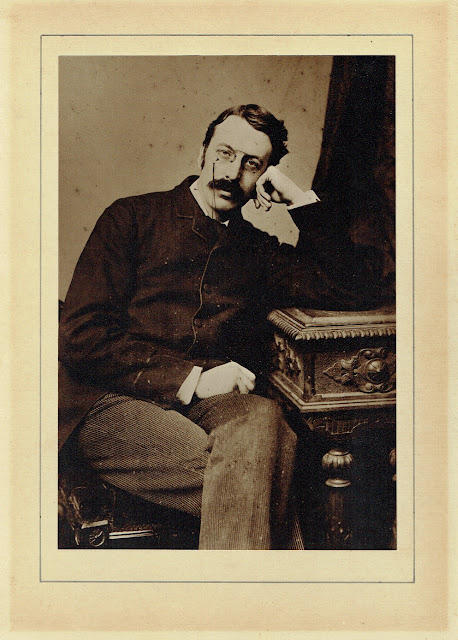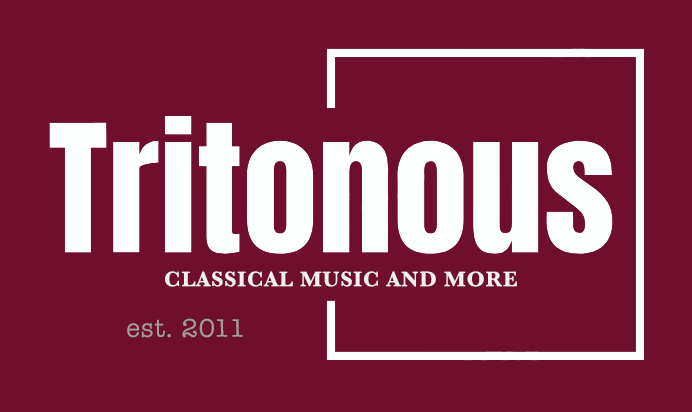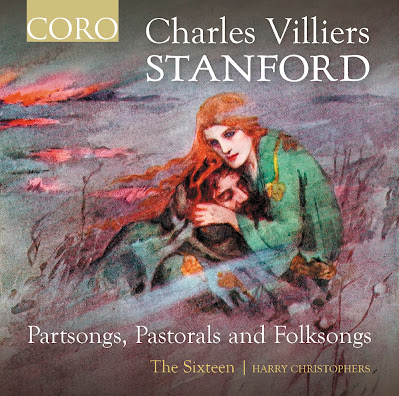Stanford: Partsongs, Pastorals and Folksongs; The Sixteen; Harry Christophers; CORO
Reviewed 22 July 2024 by Tony Coooper
Punctuating Sir Charles Villiers Stanford’s centenary, Harry Christophers and The Sixteen have just issued 17 première recordings of his works, Partsongs, Pastorals and Folksongs on their CORO label.
As a composer Sir Charles Villiers Stanford (who received his knighthood on King Edward VII’s coronation) might not be a household name but he’s well remembered as a teacher of several generations of British composers and untiringly campaigned for a national opera company as he saw the genre of opera as a vital catalyst in Britain’s musical renaissance.
Although highly lauded during his lifetime as an exceptional composer of large-scale works for chorus and orchestra, posterity, however, has been less kind to him. The musicologist, Robert Stove, wrote: ‘Sir Charles Villiers Stanford has not so much been neglected but posterity has derived malicious satisfaction from ostentatiously yawing in his face.’ A former pupil, Ralph Vaughan Williams, wrote: ‘In Stanford’s music the sense of style, the sense of beauty, the feeling of a great tradition is never absent. His music is in the best sense of the word Victorian, the musical counterpart of the art of Tennyson, Watts and Matthew Arnold.’
A busy man, Stanford composed roughly 200 works including seven symphonies, about 40 choral works, nine operas, 11 concertos and 28 chamber works in addition to songs, piano pieces, incidental music and organ works. Stanford’s technical competence was never in doubt as composer, Edgar Bainton, wrote: ‘Whatever opinions might be held upon Stanford’s music – and they’re many and various – it is always recognised that he was a master of means.’
It has been suggested by countless critics, too, that Stanford’s music lacked passion. In his operas, for instance, critics found music that ought to convey love and romance failed to do so. His church music, though, is ‘a thoroughly satisfying artistic experience but one that’s lacking in deeply felt religious impulse’. And while Stanford had a real gift for melody, often infused with the contours of Irish folk music, he never emulated comic operas but produced oratorios that ‘only occasionally matched worthiness with power and profundity’.
 |
| Charles Villiers Stanford (Photo from the Stanford Society) |
An Anglo-Irish composer, music teacher and conductor of the late Romantic era, Stanford was born on 30th September 1852 in Dublin, the only child of the city’s most eminent lawyer. He grew up in a highly stimulating cultural and intellectual environment and his childhood home was the meeting-place of countless amateur and professional musicians. In fact, his father was a capable cellist and singer and his mother a very competent pianist.
While still an undergraduate at Queens’ College, Cambridge, Stanford (who also studied in Leipzig and Berlin) was appointed organist of Trinity College, Cambridge. In 1882, aged 29, he was one of the founders of the Royal College of Music where he taught composition for the rest of his life. From 1887, he was also Professor of Music at Cambridge. As a teacher, Stanford was sceptical about Modernism and based his instruction chiefly on classical principles as exemplified in the music of Brahms. Among his pupils were rising composers whose fame went on to surpass his own such as Gustav Holst and Ralph Vaughan Williams.
Stanford showed early musical promise, though, and took violin, piano and organ lessons. His teachers were of the highest calibre including former students of Ignaz Moscheles. He gave his first piano recital for an invited audience at the age of seven presenting works by Beethoven, Handel, Mendelssohn, Moscheles, Mozart and Bach. And long before he reached the age of 12, Stanford could play all of Chopin’s 52 mazurkas while his earliest composition attempts emerged at the tender age of eight.
Not entirely unexpected, Stanford’s father wanted his son to follow his professional path and enter the legal profession much in the same way as Handel’s father did. He objected to his son taking up a career in music on the grounds that the profession was not a reliable source of income. In fact, Handel’s father would not even permit young George Frideric to own a musical instrument. It was his mother who was supportive and encouraged him to develop his musical talent. Thankfully, Handel reluctantly agreed to study law at his father’s expense and insistence but, not surprisingly, he eventually gave it up as his passion for music could not be suppressed.
Maybe it was a bit easier for Stanford whose parents wholeheartedly agreed that he should pursue a musical career instead of law. Therefore, in 1870, he won an organ scholarship to study at Queens’ College, Cambridge. He was in his element at Cambridge and composed prodigiously and was soon elected assistant conductor to the Cambridge University Musical Society (CUMS) and attracted a roster of international musicians to perform with it.
On the recommendation of Sir William Sterndale Bennett, Stanford spent the last six months of both 1874 and 1875 in Leipzig. He studied piano with Robert Papperitz and composition with Carl Reinecke. As Stanford reported: ‘Of all the dry musicians I’ve ever known, Reinecke was the most desiccated. He had not a good word for any contemporary composer, he loathed Wagner, sneered at Brahms and had no enthusiasm of any sort.’ To round off his continental study tour, Stanford spent some time in Berlin working with Friedrich Kiel. ‘I learned more from him in three months,’ he fondly recalled, ‘than from all the others in three years.’
On returning to Cambridge in January 1877, Stanford quickly became known as a conductor and composer. He conducted the first British performance of Brahms’ Symphony No.1 in C minor while completing his own First Symphony in B flat major. The oratorio The Resurrection quickly followed along with his Second Symphony and the Piano Quintet. As organist at Trinity, Stanford composed some highly distinctive pieces of church music.
At the age of 35, Stanford was appointed Professor of Music at Cambridge and his students included Coleridge-Taylor, Holst, Vaughan Williams and Ireland. By all accounts, he was not an easy teacher. He only taught ‘one-on-one’ tutorials and when students went into the teacher’s room, they came out badly damaged! Apparently, Stanford’s teaching did not follow a prescribed plan or method. Joining the staff of the newly inaugurated Royal College of Music as a Professor of Composition and conductor of the orchestra in 1883, Stanford exerted considerable influence on a long list of students and instigated an opera class with an annual production.
Stanford also took on the conductorship of The Bach Choir, the Leeds Philharmonic Society and the Leeds Triennial Festival and received honorary degrees from Oxford, Cambridge, Durham and Leeds. As Stanford was known as a hot-tempered and quarrelsome man, confrontations quickly ensued with Stanford acidly writing: ‘Elgar, cut off from his contemporaries by his religion and his want of regular academic training, was lucky enough to enter the field and find the preliminary ploughing done.’
In his writings on music, Stanford frequently uses visual metaphors and references in relation to painting and sculpture. His ideas on the subject can be reduced to this simple statement: ‘A piece of music can survive bad texture and instrumentation but never bad melody or design.’ He famously wrote: ‘Colour, the god of modern music is inferior of rhythmic and melodic invention although it will always remain one of its most important servants. Fine clothes will not make a bad figure good.’
In the musical culture war of the period, Stanford always sided with Brahms against the Modernists, although he had a great admiration for Wagner. He counted Berlioz and Liszt as lesser practitioners of the musical art and he most bitterly objected to the music of Richard Strauss. Concerning Debussy and the new French school that emerged in the 1890’s, Stanford was deeply ambivalent. He was tormented by musical and aesthetic dichotomies at the end of his life. Always wrestling with his status in relation to Irish and English culture, he experienced what Yeats described as ‘my hatred tortures me with love, my love tortures me with hate’.
However, celebrated as one of the leading musicians of his generation Stanford is, perhaps, best remembered for his choral writing. Therefore, his exquisite vocal lines and imaginative storytelling is present in the four choral cycles showcased in The Sixteen’s well-prepared album featuring multiple première recordings including ‘Plighted’, ‘Larghetto’ and ‘Wilderspin’ from Eight Partsongs; ‘Damon’s passion’ and ‘Phoebe’ from Six Elizabethan Pastorals and the entirety of Nine Irish Folk Songs.
Stanford’s dedication to the poetry of Mary Elizabeth Coleridge is also reflected in this collection, particularly her words regarding loss and change, portrayed beautifully in The Guest with its unsettling narrative. In Stanford’s hands, the poem is presented as a ‘mini opera’ thereby allowing the music and drama to take precedence over a short span of three-and-a-half minutes.
Harry Christophers, Founder and Conductor of The Sixteen had this to say: ‘The Sixteen has spent the majority of its existence performing and recording sacred music until I made a decision last year to release an album devoted solely to secular music Sirens’ Song allowing me to rediscover Stanford’s beloved ‘The Blue Bird’. I had no idea that this jewel was one of a cycle of Eight Partsongs. Therefore, with the help and enthusiasm of Jeremy Dibble, I’ve now been introduced to a plethora of Stanford’s choral works, many of which receive première recordings on this album.
‘It is the simple things that Stanford does incredibly well. He writes exquisitely for voices and his storytelling is so imaginative. Stanford’s capable musical writing has made our experience of recording them amazingly rewarding and beautifully refreshing. They’ve been a revelation and such fun to perform. We can’t wait for you to listen.’
And listen, I certainly did. Right from the first song ‘Oh! breathe not his name’ (from Six Irish Folksongs) to the final track ‘Emer’s farewell to Cucullain’ (sung to Londonderry Air), it provided me with 75 sublime minutes of heavenly and pastoral music that truly captured the beauty, serenity and peacefulness of Stanford’s writing heard on a restful, balmy and adorable summer’s day.
As an aside, the lavishly furnished and decorated Roman Catholic Church of Our Lady of The Assumption and The English Martyrs at Cambridge (OLEM) possesses a fine three-manual pedal organ of 2018 pipes built by the Leeds firm of Abbott & Smith and designed by Charles Villiers Stanford who drew up its specification and gave its inaugural recital in 1890. The organ was renovated in 2002 by Nicholson & Co Ltd of Malvern, Worcestershire. Currently, the music director and organist at OLEM is Nigel Kerry, a graduate of Oxford University who also studied at the Royal College of Music with Nicholas Danby. He took up his appointment in 1998.
Although Stanford wrote seven symphonies his best-remembered pieces are his choral works for church performance, chiefly composed in the Anglican tradition. He was a dedicated composer of opera but none of his nine completed operas, sadly, has endured the test of time. Some critics regarded Stanford, together with Hubert Parry and Alexander Mackenzie, as responsible for a renaissance in music from the British Isles but after Stanford’s conspicuous success as a composer in the last two decades of the 19th century, his music was eclipsed in the 20th century mainly by Elgar.
Hopefully, this new recording by The Sixteen will garner some extra interest in Stanford in his centenary year while the BBC Proms Choral Day (Prom 63), Saturday, 7 September, features Harry Christophers and The Sixteen, accompanied by organist Simon Johnson, performing an enlightening and all-encompassing British choral programme comprising Stanford’s Three Motets, The Guest, When Mary thro’ the garden went and To a tree along with works by Parry, Gardiner, Harris, Ireland and Elgar.
Sir Charles Villiers Stanford (1852-1924) – Six Irish Folksongs, Op. 78 (1901)
Sir Charles Villiers Stanford – Eight Partsongs, Op. 127 (1910)
Sir Charles Villiers Stanford – Six Elizabethan Pastorals (Set I), Op. 49 (1892)
Sir Charles Villiers Stanford – Nine Irish Folksongs
Sir Charles Villiers Stanford – Emer’s farewell to Cucullain (1923)
The Sixteen
Harry Christophers
Recorded at All Hallows Church, Gospel Oak, 5-7 March 2024
CORO COR16207 1CD [75:53]
Released on 6 September 2024
The blog is free, but I’d be delighted if you were to show your appreciation by buying me a coffee.
Elsewhere on this blog
- Music of a Silent World: Chanticleer in an eclectic recital exploring the natural world – review
- A Road Less Travelled: in advance of its London premiere, Alec Roth discusses his 2017 song cycle to poems by Edward Thomas – interview
- Drawing you in: Ensemble OrQuesta combined physical theatre with comedy & a sense of anger in Mozart’s Le nozze di Figaro at Grimeborn – opera review
- To Lviv with Love: Paul
Mann combines conducting in the Ukraine with investigating neglected
composers for Toccata Classics, including the Swiss composer Richard
Flury – interview - Prom 52: Intelligent, vivid & satisfying account of Bizet’s Carmen from Rihab Chaied, Evan LeRoy Johnson, Anja Bihlmaier at Glyndebourne’s visit to the BBC Proms – opera review
- Prom 50: Two rarities and a classic from Jakub Hrůša and Czech Philharmonic – concert review
- Prom 49: A consumate & deeply felt account of Suk’s Asrael Symphony crowns the Czech Philharmonic’s first Prom appearance – concert review
- Far from special interest: discs of brass band music by Arthur Bliss and Malcolm Arnold, two brilliant and highly satisfying portraits – record review
- Into the unknown: soprano Aoife Miskelly makes her debut with Vache Baroque in Pergolesi’s rarely performed opera, L’Olimpiade – interview
- Responses to Thomas Hardy: composer
Arthur Keegan’s complex web of music new and old, atmospherically
performed by Lotte Betts-Dean, James Girling & Ligeti Quartet – record review - Home








